
As an SEO strategist, you're expected to drive organic growth. A fundamental question to ask here is: how do we define growth?
Growth can be any of the following:
- Improve ranking positions in Google
- Increase organic search traffic
- Drive a higher number of leads
There are two foundational elements missing from all 3 statements above:
1. The lack of precision in knowing which metric actually means growth.
2. The lack of an end goal (as in a final number) that you want to achieve as a result of growth.
Having worked as an SEO strategist for multiple agencies/companies, developing SEO strategies for many SaaS products, and leading teams of smart SEO strategists, I’ve learned a ton of lessons about the art of setting SEO targets.
In this post, I’ll share all my learnings, and dive deep into the methodology of deriving SEO goals. Finally, I’ll walk you through an example of setting and breaking down a broad SEO target for a SaaS company.
How to set SEO targets
Here's the ‘TL;DR' simplest version of this post in 30 seconds.
1. Remember that SEO does not exist in a bubble. Align with the overall company goals.
2. Pick a business-focused end goal. For example: increase MQLs by 300%.
3. Ask ‘why' many times to understand & ensure the logic behind your goal.
4. Develop your strategy. What will you do? What resources will you need? What will it cost?
5. Track rankings, organic traffic, and your business metric (e.g. MQLs) to monitor progress.
Ready to dive much deeper, with examples? Let's dive in.
Why it’s important to set targets in SEO
SEO, just like any other marketing channel, is supposed to supplement your business growth. Without setting and regularly tracking your SEO targets, you’re running blindly with no destination.
Moreover, your whole strategy will lack objective reasoning without having a target you could aim for and you could be directly damaging your business while living in your SEO bubble.
Think about it: how do you even decide the scope of work, the resources that you’d need, and the budget/expenditure that will go into the execution without knowing what is it that you want to achieve?
See the flaw in this approach? Your SEO target is supposed to be the guiding light of your project as a whole.
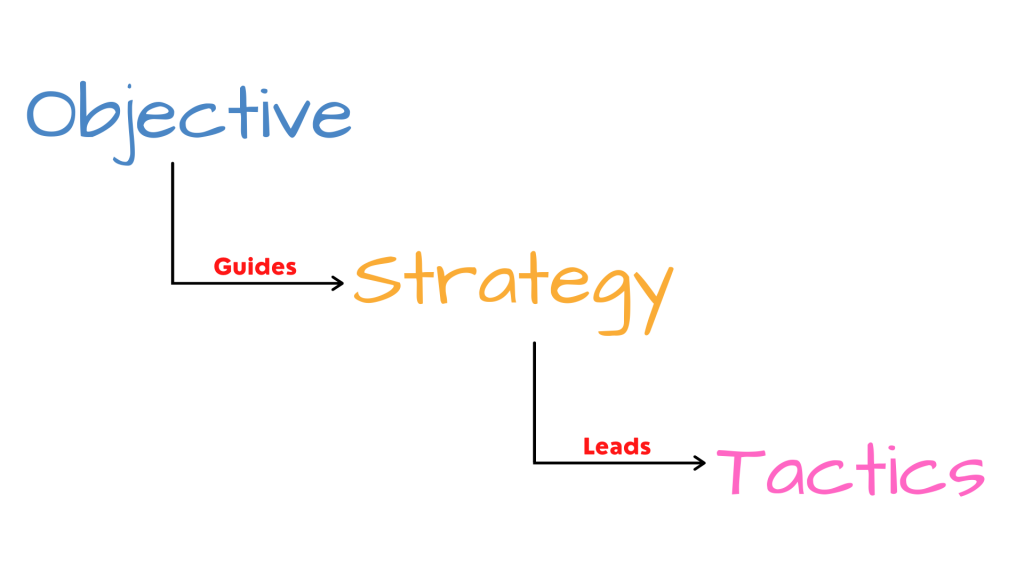
Choosing the right KPIs
There’s a big flaw in the way SEOs think of performance measurement today. Obsession with SEO-focused metrics like rankings and vanity engagement metrics like bounce rate might make you look like the campaign is a success. Still, without business metrics backing it up, it's all a fugazi.
So the question is, what is the right way to track your SEO success? And what kind of key performance indicators should you be tracking?
The recommended solution is something that I call the rankings-to-revenue framework.
What this framework entails is that you can use SEO-focused metrics (like rankings) as initial indicators of success but in the end, you have to tie all of it to solid business-concentrated metrics (like revenue).
Here’s what the KPIs division looks like:
1. SEO-focused metrics
Keyword rankings
Rankings, although as a standalone metric would be considered vanity, still can be an indicator of success for the initial period (the inceptive 2-3 months) when the outcome is uncertain.
The way I like to keep a track of it is to check the month-over-month progression of the primary keyword per page using a SERP tracker. Obviously, if you’re ranking for the primary keyword you targeted on a page, all adjacent keywords are going to follow.
Organic search traffic
The biggest leading indicator of any SEO campaign is organic search traffic. The reason is simple, you need the traffic to drive prospective users/customers. Also, search traffic as a metric helps you see beyond rankings which mostly is a much-needed perspective since rankings alone can depict the wrong picture. For example, you can grow in traffic despite having lost in rankings for a particular keyword.
2. Business-related metrics
Note: These examples are for B2B SaaS. The metrics change depending on your business model. e.g. for eCommerce, we could use ‘transactions’.
MQLs
For a B2B company, measuring the number of marketing-qualified leads would be a significant metric to track as the conversion rate from traffic to MQLs can indicate how on-point is your organic search strategy. What’s important here is to define what ‘qualified’ means for your pipeline. If they’re hundreds of e-book downloads and the sales team is required to follow up, then you’re setting yourself up for failure. If (for a SaaS company for example) MQLs are product demo requests, then it makes sense.
Sales team win-rate
Tracking the win rate of your sales team is as important, if not more, as tracking the number of inbound leads driven. This is often neglected by SEOs since they set an arbitrary number of MQLs for themselves that they need to drive every month without measuring its end-level impact. The win rate of your sales team in converting leads to paying customers helps connect the missing dots and it tells you a lot about the level of qualification of those leads.
SEO-sourced revenue
From the win rate, you should ideally go one step ahead and figure out how much is the revenue contributed to the company from the customers brought through search traffic as a medium. This additional step will help you comprehend how much of an impact is SEO able to drive in the bigger picture of the company’s total revenue generated as a result of all marketing activities.
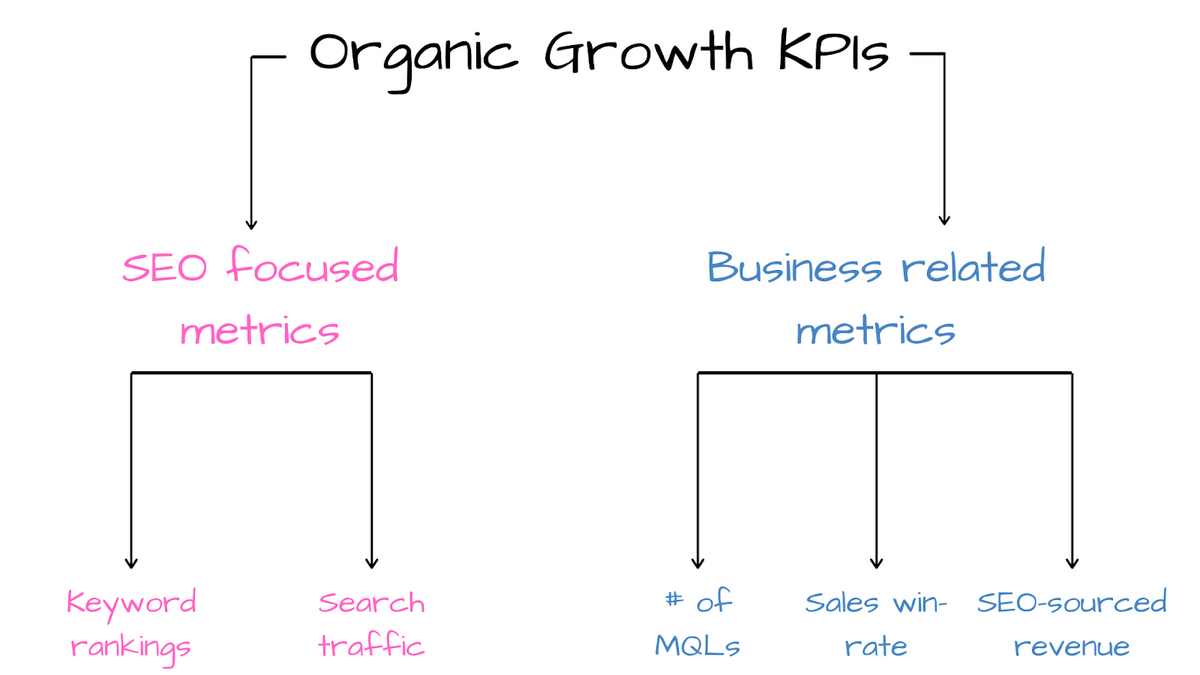
The reason why this rankings-to-revenue framework is so effective is that it prevents you to devise strategies or execute tactics that don’t drive or connect somehow to revenue in the end. As a result, saves you a ton of resources and time.
What SEOs get wrong about setting SEO goals
SEOs often fall into the pit of setting intangible and abstract kind of SEO goals. For example, often times the target will sound something like: “Increase the organic traffic”.
The problem here isn’t just that the goal lacks a number. Even if there’s a precise number that SEOs are trying to hit in organic search traffic, often times what’s lacking is a logic behind it.
In simple words, the missing element is the ‘Why’ behind every decision.
Let’s say, your team decided they want to achieve 100,000 monthly search traffic by the end of the year.
- But why is this number 100,000 exactly? Why not 150,000 or 200,000?
- Why is the timeline only the end of the year? Why not 6 months or more than a year?
- And then most importantly, why are we even working on an SEO strategy? What exactly is this number in traffic going to contribute to the business overall?
It's the ‘Why’ that can make or break your SEO targets.
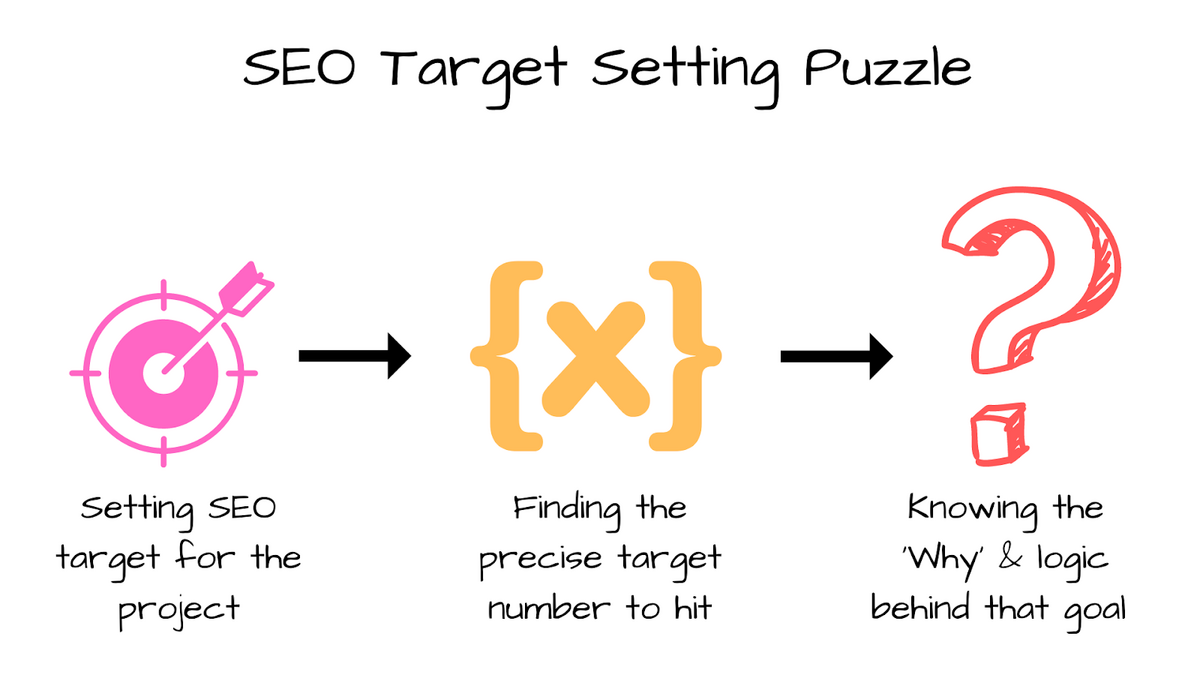
How to set SEO targets: step-by-step walk-through
Setting SEO targets isn’t complicated if you think of SEO as a channel for business growth. Using the framework mentioned above, the objective should be to tie everything with a tangible business goal in the end (like revenue). And base projections on that goal.
If you don’t feel like your strategy ties back to a very precise business target at the end of the string, it's anything but a strategy.
Let’s see how it's done:
STEP 1. Set a business-focused end goal
If you’re working at a company, as a part of the marketing or growth team, the best way to think of your SEO target is to get an end goal from the company’s/department’s leadership.
Remember, this goal needs to be a SMART one (specific, measurable, achievable, relevant, and time-based). Here are a few examples of SMART marketing goals:
- Achieve $1 million in MRR in the coming 18 months.
- Increase MQLs by 300% by the end of the year.
- Reach 150 monthly paying customers in the coming 6 months.
Companies usually follow a hierarchical model of setting and delegating targets which means you, as an SEO, will be fulfilling a portion of the marketing/growth team’s end objective.
Once you have that end goal from your marketing leadership or CMO, you have to see what portion of that goal can be achieved with SEO as a channel.
For example, if the goal is to achieve $1 million in MRR, perhaps SEO can contribute $650,000 of that based, on the current split of revenue owned by all marketing channels.
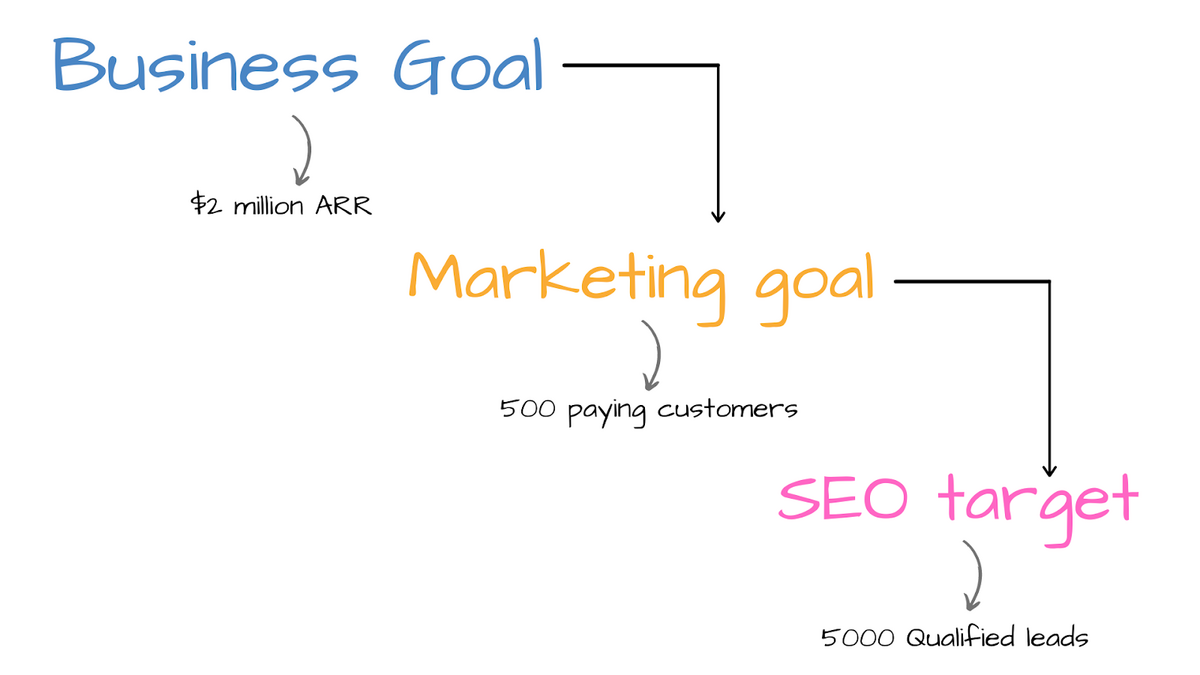
STEP 2. Develop a strategy based on the end objective
Once you have the end goal that you want to achieve with SEO as a growth channel, the next step would be strategy development.
A strategy refers to a plan of action that places the end goal, takes all of the opportunities available, and works backward to define the areas of work and the scope needed to meet the outcome.
Unfortunately, the term SEO strategy has been so commonly used that in order to decipher its true meaning, I’d need to explain what a strategy is not:
A strategy is not a roadmap, nor an objective. In fact, a roadmap and objectives can both be a part of a strategy.
As Kevin Indig puts it:
If you used Simon Sinek’s Golden Circle, the strategy would be the “why”, the roadmap, the “what”, and the objectives, the “how”.
Kevin Indig
So what does an SEO strategy includes then? An SEO strategy would be a mixture of the following:
- The end goal – what is it that we’re trying to achieve? [the revenue goal etc.]
- The roadmap – The plan of action with a specific timeline [each objective/time+effort]
- The objectives – The actions to be completed to achieve the goal [sitemap structuring, content creation, internal linking architecture]
- The components – The areas those objectives fall into [technical, content, links, etc.]
- The resources – How much capacity do you have [writers, strategists, developer’s assistance, link-builders]
- The scope [# of pages to create, # of links to build, etc.]
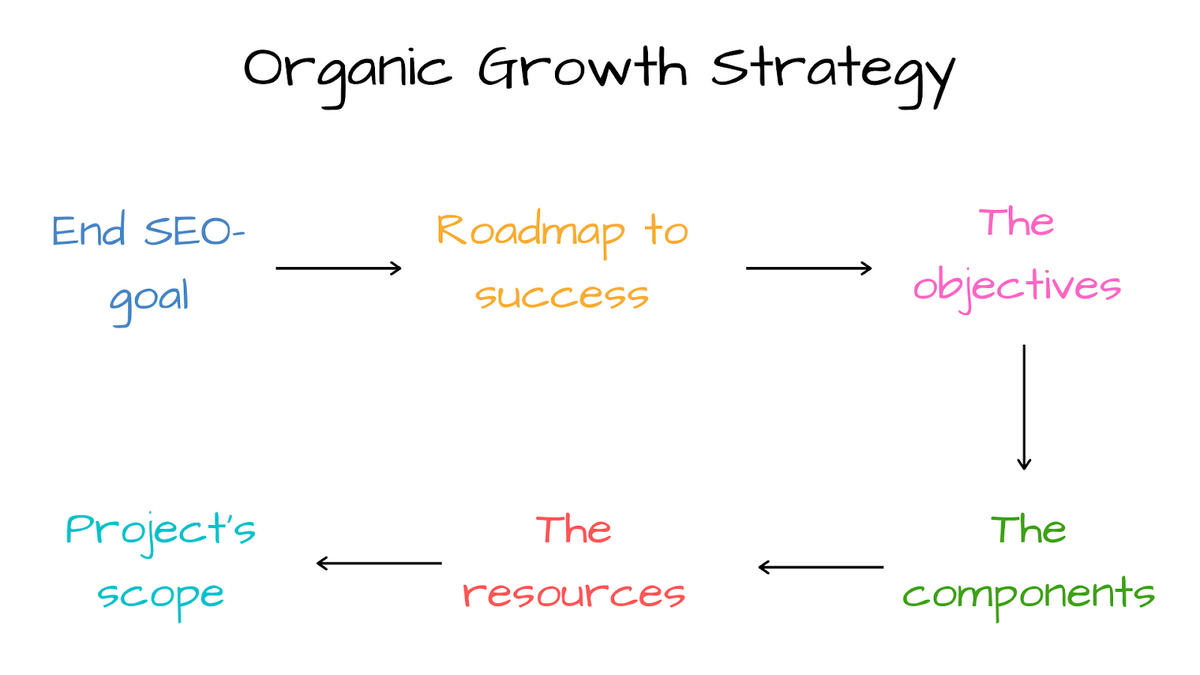
STEP 3. Get the execution ball rolling
Finally, once you have the strategy devised you have about 80% of the work done. The last but not least part of the puzzle is execution: just making sure there are systems and processes for everything that needs to be done.
Although this feels like the least tricky part, you don’t want to underestimate it. The reason is that everything we’ve done until here was backed by data but still theoretical.
For effective execution, you just have to break your strategy down into quarterly and monthly targets both in terms of the output of the resources (your team) and the outcome (traffic/revenue).
When it comes to output in the real world, it's always a rocky road as you’ll face bottlenecks, indecisiveness, and hesitation in ownership sometimes. And all of this will add up to take you away from the end goal. If things go wrong, your contingency plan will require more work than your strategy itself.
To tackle this you’d have to invest time in developing operational guides and putting together SOP documents to bring clarity to the roadmap.
Example: translating a business goal to an SEO strategy
Now, let me run you through a hypothetical example to make things crystal clear:
- Business goal: Achieve +233% growth in net ARR – from $300,000 to $1 million in ARR in 12 months (January – December)
- Website standard: A lot of content on the website already and opportunity to create more.
- Resources: 2 writers, SEO strategist, complimentary development support.
- Tools: Multiple SEO/copywriting tools and a project management platform.
We know the goal, and the current status and have the resources needed to achieve the objective, let’s now break this down to actual numbers.
We’re assuming this business is a SaaS product (as I specialize in this space) and I am going to walk you through the entire sheet. A ton of Google sheet screenshots and loads of numbers ahead, so bear with me:
1. Calculating the total monthly cost
You have to incorporate everything that is a cost for the business here. Meaning, salaries of the resources, any external parties involved: a content agency for example as we’re assuming in this case, as well as any tools being used regularly.
Here’s what the breakdown would look like:

2. Setting SEO target against the benchmark
The next step would be to break down your goal of revenue to a more granular layer of KPIs and compare it against the current state. Make sure it's all based on actual data, like conversion rates.
For a B2B SaaS company, you’d need to know the current number of paying customers versus the number of customers it’d take to hit the revenue target. Then based on the sales win rate and organic traffic to MQL conversion rate, you can tie traffic to paying customers, and in-turn revenue.
You’d also need the numbers for the customer’s lifetime value and the per-month revenue a customer brings. Finally, you can put it all together like this:

3. Estimating return from content re-optimization efforts
Remember the scenario we’re using as an example here says that the website in its current state has a lot of content already. So before creating new content, we’d be re-optimizing a lot of the existing content.
In the first step, we’d estimate the extra clicks (search traffic) we can generate as a result of re-optimizing existing content. What you’d need is a list of pages (let’s assume 100 pages in this case) you determined to require re-optimization (this is something you’d need to figure out at the content audit/pruning stage). And you need the keywords for all the pages in that list (since each page ranks for multiple keywords) clustered under each page they rank for.
Once you have a list of pages to re-optimize, get the following 2 data points in a sheet:
- Total number of impressions those pages are generating – this gives us an idea of the total opportunity available.
- The CTR between positions 1st and 20th that your website receives is based on Google Search Console’s data – this would help us estimate how many clicks we can generate if we rank keywords in those positions.
- Based on the two data points above, you just have to calculate the click growth by multiplying the number of impressions with the CTR against each ranking position.
We’d be dividing all of it into 3 scenarios, based on what percentage of keywords we’re able to rank in the top 3, top 10, and top 20 positions.
Simply multiply the impressions with the average CTR of positions 1st-3rd, 4th-10th and 11th-20th, and you’ll have the estimated click growth:
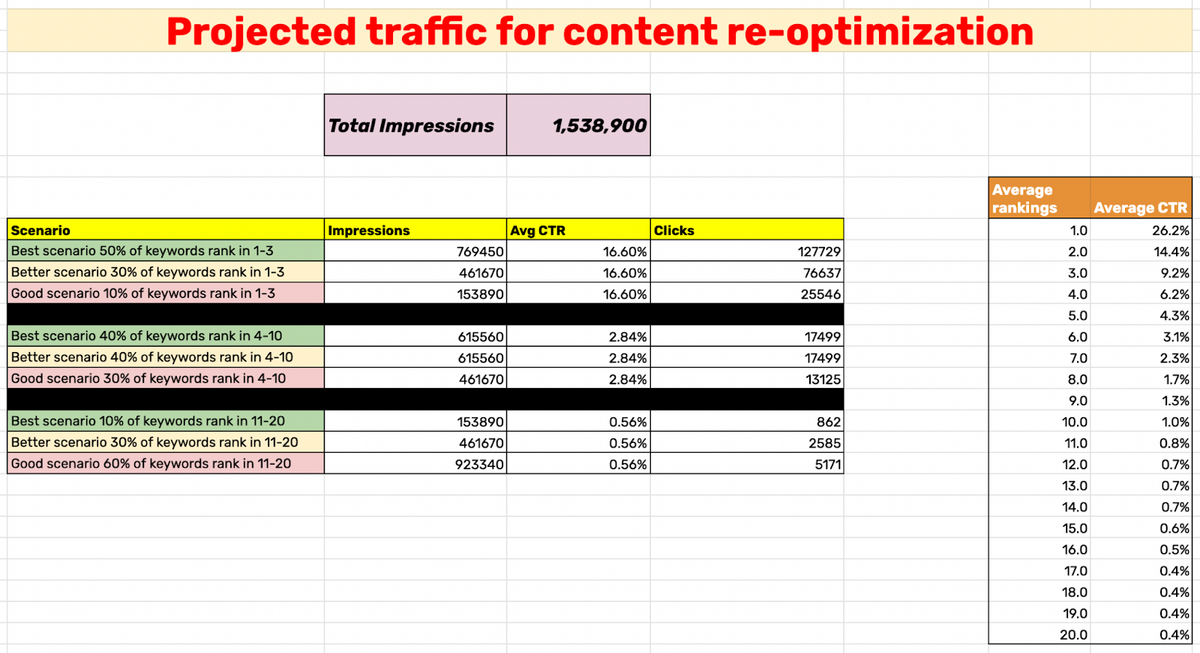
Now we have to compile the number of clicks into 3 scenarios by summing up the numbers into buckets. In simple words, sum all of the numbers in green as a total for the best-case scenario. Sum all of the clicks for yellow as a total for a better case scenario and do the same for all click numbers in a good case scenario.
One thing to remember is that the final number of clicks after summing all up, would be for the period you took the data out (which in this case was 3 months to eliminate seasonality effects) so we’d need to divide the total of each scenario separately by 3 to attain the monthly figure.
Finally, using the same conversion rate, win rate, and ACV, we can calculate the expected revenue:
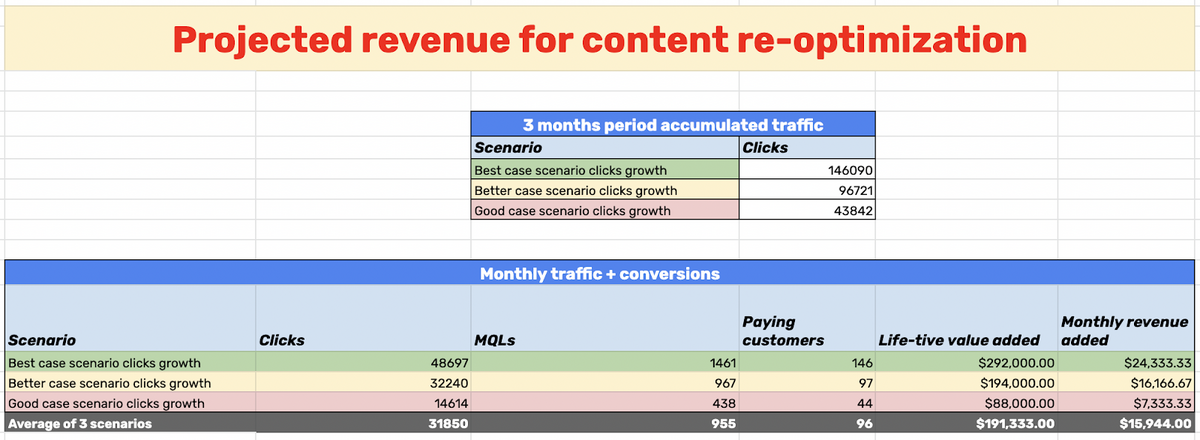
So we have the numbers for content re-optimization. Now since we’d also be planning new content creation, let's see how we can do those projections.
3. Projected traffic for new content production
Projecting traffic for new content is fairly simple if you have the list of topics you want to attack.
You just need to list down all of the keywords with their global search volume
You use the CTR against each ranking position to determine the clicks you can acquire as a result of ranking at various spots for those keywords.
Based on traffic to MQL conversion rate, you can estimate the number of MQLs generated as a result of ranking in the top 3, top 10, and top 20 positions (again, dividing it into scenarios)
PS: I am putting just 6 keywords (all from one topic cluster: ‘Sales Prospecting’) as an example here but you should add as many keywords as you want to go after.
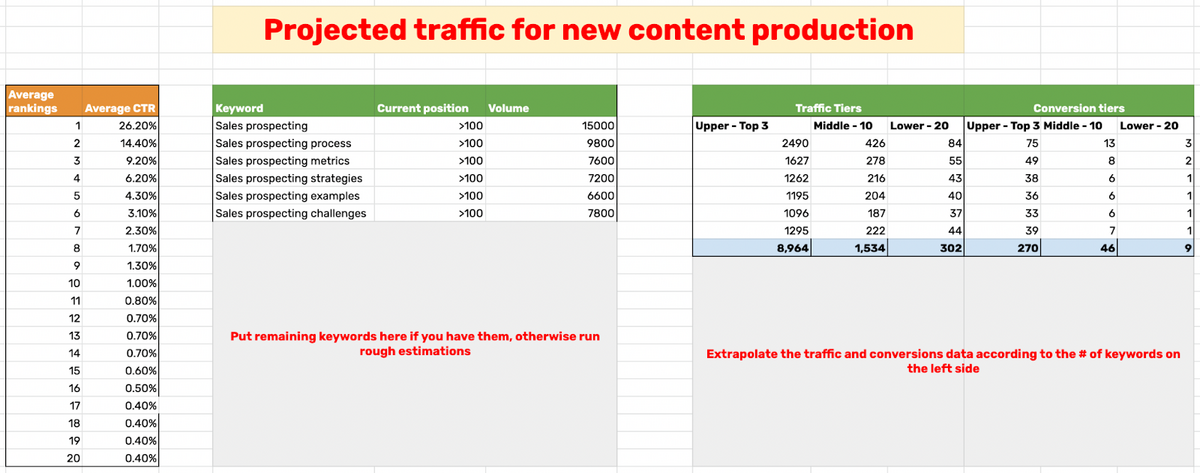
The next step would be to calculate the # of MQLs you can generate (sticking with the conversion rate used already) and then take the average of all 3 scenarios for both traffic as well as MQLs.
You’d also need to know the total number of pages you’d need to create for this. If you have the list of primary keywords already, you’d know how many pages you’d need to create.
Since I am using this as an example, I’ve just used the logic that on average there’d be 6 chapter pages/keywords for every topic cluster (as in the case of ‘Sales Prospecting’ above) and assumed that there’d be about 30 topic clusters that we can publish content in.
So simple, math would be: # of pages needed = 6 (chapters in each cluster) X 30 (total topic clusters estimated) = 180 pages.
Remember, these 180 pages are for new content creation, in the stages above we established 100 pages for content re-optimization with their projections done separately.
Here’s how the traffic numbers will convert to MQLs among those 3 scenarios:

3. Generating overall growth projections
Finally, we blend everything together to formulate the growth projections for the whole project, divided by months. Quick recap of what we have at this point:
- Target revenue (monthly + annual) that we want to achieve
- Estimated search traffic from content re-optimization and new content creation
- # of paying customers required
- Number of MQLs required a month
- The monthly cost that to incur in the project
What we’d need to calculate further are the following:
- The total search traffic estimated from content re-optimization and new content creation
- $ of MQLs and paying customers against the new total traffic number
- The cost of acquisition per paying customer
- ROI on SEO efforts all-together
The best part is that if you simply divide the total traffic (re-optimization + new content creation) by the total number of pages (re-optimization pages + new content creation pages) you’ll get a traffic per page figure.
Now multiply that ‘traffic per page figure’ by whatever is the monthly scope of your project in terms of the number of pages you will create/re-optimize every month. The last part of the puzzle is to calculate the cost of acquisition per customer and the overall ROI on SEO efforts altogether.
Finally, you’ll come up with a sheet like this:
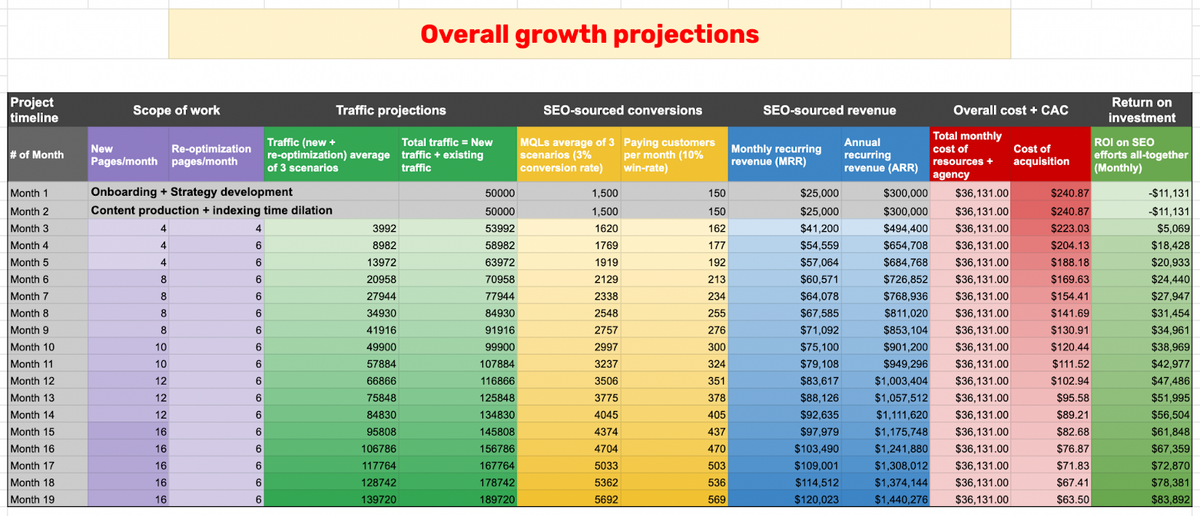
Since the screenshot shares a ton of numbers and metrics, let me break down some key insights here:
- The first two months would be in loss because that period would go to strategy development and the time dilation it’d take for the content to be indexed and start showing up in SERPs.
- The cost of acquisition per customer at the start versus at the end of the project would have come down by 73%. Starting from $240.87 and ending at $63.50.
- The monthly ROI of this SEO project for the company would have improved by +1555% from 1st month versus the 19th month – starting from $5,069 to end at $83,892.
- And last but not least, the targeted value of revenue (MRR) that we set at the start of the project would be achieved in the 12th month of the project.
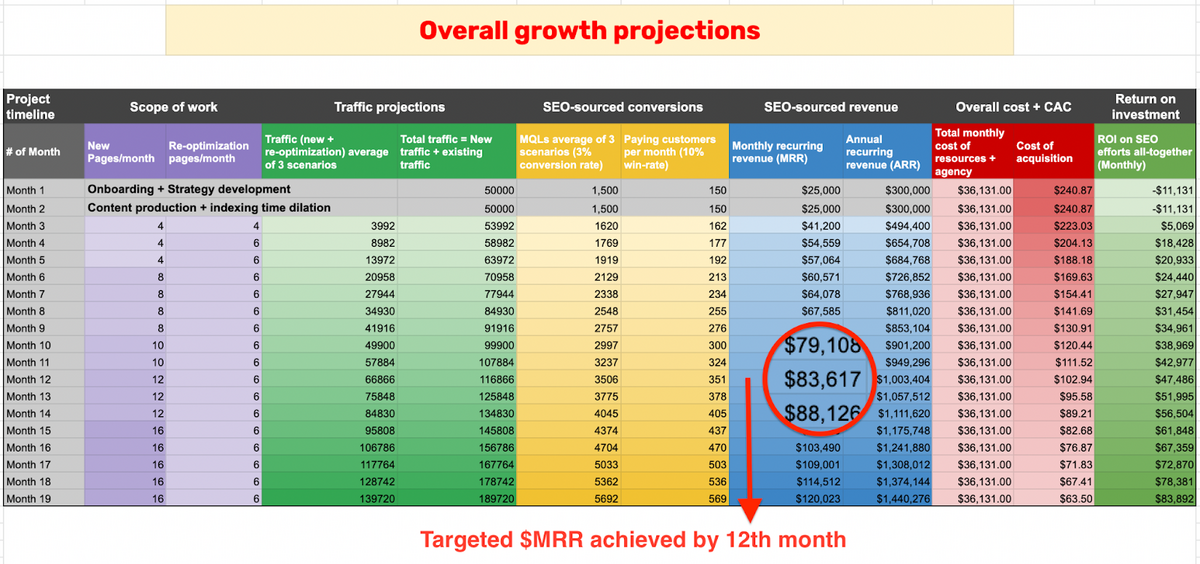
Tracking & reporting your progress
When it comes to tracking and reporting progress, these output/outcome numbers would then be tracked on a weekly/monthly/quarterly basis to ensure the project is on track.
Here are a few tips for recording the regular progress of your SEO goals:
1. Set up a dashboard
The best way to track SEO results is to set up a dashboard where you can look at data in real time. The benefit of using a dashboard is that you save up a lot of time and manual effort since the data is automatically pulled all the time.
There are a lot of SEO dashboard software tools that you can pick from. The one, I’d recommend here is Google Data Studio since it comes with a solid free version and its very flexible.
2. Turn numbers into insights
Despite having you go through all these metrics and sheets, still numbers are useless without some sort of insights backing them up. Once the project has taken off, and you’re compiling data, it's extremely vital to analyze that data so you can gather important insights, spot trends, and identify patterns to further facilitate growth.
3. Re-frame your strategy/tactics
Once you have those insights coming in from your data, the next step is to ensure you’re updating your strategy, re-framing your tactics, and re-examining your techniques if needed. For example. if you’re noticing one topic cluster converting way better than others, you should focus on that more. Or, if some bottom-of-the-funnel pages aren’t performing as well as you expected, perhaps it's time to analyze the user experience and search intent, etc. Your data would be telling you a very precise story, which if you can decode, you’d be able to take the growth off the charts.
4. Communicate to leadership
Finally, you need to make sure you’re communicating all of the important highlights to your leadership. Remember, your CMO doesn’t care about rankings, nor in fact about traffic at the end of the day. Those SEO metrics can be indicators of early success for you, but for them, revenue is what matters. Make sure all your SEO report revolves around revenue growth or whatever the objective was. Tell them how close you are to your end goal and ensure they feel a part of the journey.
Conclusion
Setting a solid SEO, although seems complicated, won’t be a complex task if you can practice just one principle constantly: put yourself in the shoes of your C-suite leaders and evaluate if your SEO targets still make sense.
If you’re thinking from the perspective of the CEO, CMO, or CFO of the business, your priorities will change, you’ll zoom out of the SEO bubble and think of the customer first, and you’ll value everything that can (directly or indirectly) be tied with revenue and ignore the rest.
Remember, you’re a part of the vision of your company, not just a person who ranks pages.
Got questions? Get in touch with me over LinkedIn!
